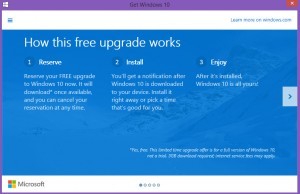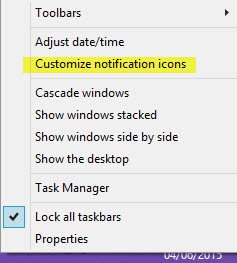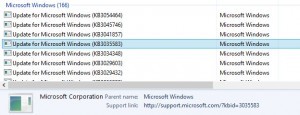Richard Tubb's Blog, page 84
June 4, 2015
How to remove the Windows 10 Upgrade icon
 If you are a Windows 7 or Windows 8 user, then you may have noticed a new icon appear in your notification bar over the past few days.
If you are a Windows 7 or Windows 8 user, then you may have noticed a new icon appear in your notification bar over the past few days.

The “Get Windows 10″ icon is part of an update (specifically KB3035583) which Microsoft have pushed out to Windows 7 and Windows 8 PC’s to encourage people to register for the free Windows 10 upgrade which will become available on July 29th, 2015.
Despite the allure of a free Operating System upgrade, I know that many readers of this blog — IT Professionals — will be inundated with support requests from clients as well as friends and family who are intrigued/perturbed/irritated by the icon and ask “How can I remove the Windows 10 upgrade icon”?
With that in mind, here’s a quick guide to clicking/hiding/removing the Windows 10 Upgrade icon.
What happens if you click the Windows 10 Upgrade icon?
If you click the icon then you will be offered the opportunity to reserve a free upgrade to Windows 10 from Microsoft. You can provide your email address to receive a confirmation and further updates as the upgrade process rolls forwards.
Hide the Windows 10 Upgrade icon
If you want hide the Windows 10 Upgrade icon, then here’s how to it on Windows 8:-
Right click in the task bar notification area and select “Customize Notification Icons”
Then change the “GWX – Get Windows 10″ behaviour setting to “Only show notifications” or “Hide icon and notifications”.
Remove the Windows 10 Upgrade icon
If you want to remove the Windows 10 Upgrade icon from your PC altogether, then here’s instructions for Windows 8:-
From the Control Panel, open “Add or remove programs”
From the left hand panel, click “View installed updates”
Click “Update for Microsoft Windows (KB3035583)” and click Uninstall.



June 3, 2015
How to end procrastination with the Pomodoro technique

photo credit: Procrastination – A1 via photopin (license)
Have you ever needed to do something — something important, perhaps even urgent, but you have found yourself avoiding the task at hand in favour of something — anything — else?
I have. Too often. In fact now seems a good time to confess to the world — my name is Richard and I’m a procrastinator of the highest order.
There! It’s done! It’s out there. I’d put that admission off for long enough (a little procrastination joke there). Joking aside, I know I’m not alone in being a procrastinator. In my day-to-day work with business owners, the most common challenge I hear from people trying to achieve tasks is simply getting started.
So why is it so difficult to get started?
The Resistance to getting started
 In his fabulous manifesto “Do the Work” — which I recommend everyone read — the author Steven Pressfield tackles the idea that many of us absolutely want to do the work that matters, but don’t know where to start. So we don’t start at all. Pressfield names this roadblock “the Resistance” and calls it the enemy of doing great work.
In his fabulous manifesto “Do the Work” — which I recommend everyone read — the author Steven Pressfield tackles the idea that many of us absolutely want to do the work that matters, but don’t know where to start. So we don’t start at all. Pressfield names this roadblock “the Resistance” and calls it the enemy of doing great work.
I hit the Resistance every single day. When I need to write blog posts. When I need to make telephone calls. Even when I need to write a simple email. Just getting started can seem a maddening massive obstacle to overcome.
Given the amount of writing I do on this blog alone, you might find it difficult to believe that I struggle in this way. I assure you that I do. I struggle to get started doing most things that I consider important, yet those important things do get done thanks to a really simple technique I use to get me started.
The method I use to consistently get me started on the work that needs doing is the Pomodoro technique.
What is the Pomodoro technique?

photo credit: Tomatoes #1 via photopin (license)
The Pomodoro technique was taught to me by productivity expert Grace Marshall when I explained to Grace my difficulty getting started on important work.
Grace explained to me that the Pomodoro uses a timer to break down work into blocks of 25 minutes. These intervals are known as “pomodori” from the Italian for tomato (think slices of a Tomato) and if you’re struggling to get started on something, the Pomodoro technique can help.
To get started with the Pomodoro technique:-
Set a timer for 25 minutes.
Start the timer.
Work for 25 minutes until the timer rings.
Take a short break.
Repeat.
Doesn’t seem that revolutionary does it? Yet despite this, I find the mere act of setting off a timer for the non-threatening sum of 25 minutes helps me get started on work I’d otherwise procrastinate over. After all, however busy you are, who can’t find 25 minutes to get started on something?
The interesting thing is, quite often the 25 minute timer will elapse and I’ll be in my flow with the work — I’ll ignore the timer and decide to press on and get the work finished anyway. That same work that 25 minutes earlier I couldn’t even seem to get started on. Powerful.
Focus@Will
 For myself, I’ve built the website Focus@Will into my Pomodoro routine. Focus@Will is a web site that has its own Pomodoro timer built in, as well as playing background music that helps you concentrate, and I find the combination of that music and the Pomodoro technique aid me in getting started on important work.
For myself, I’ve built the website Focus@Will into my Pomodoro routine. Focus@Will is a web site that has its own Pomodoro timer built in, as well as playing background music that helps you concentrate, and I find the combination of that music and the Pomodoro technique aid me in getting started on important work.
Conclusion
Do you procrastinate? Do you struggle to get started on important work? You’re not alone.
The act of getting started, the Resistance, can be paralysing to your productivity. Stop and think, right now, about what important work have you been putting off that if you’d simply made a start on then you’d feel a whole lot better about.
The Pomodoro technique of setting a timer for 25 minutes and focusing on the job at hand may be your way of overcoming the Resistance and getting started on that important work.
Try the Pomodoro technique — after all, I’m the world’s biggest procrastinator and it helped me write this blog post!



May 26, 2015
What to do if you lose your Amazon Kindle
 I’m a big fan of the Amazon Kindle range of ebook readers. When I’m travelling my Amazon Kindle Paperwhite allows me to take a wide range of books in a single device — no more getting on to a plane or a train and being in the mood for reading a fiction book and finding I’ve only packed a business tome, or visa versa.
I’m a big fan of the Amazon Kindle range of ebook readers. When I’m travelling my Amazon Kindle Paperwhite allows me to take a wide range of books in a single device — no more getting on to a plane or a train and being in the mood for reading a fiction book and finding I’ve only packed a business tome, or visa versa.
During a recent extended trip away from home, I lost my Amazon Kindle Paperwhite eReader. I suspect I’d made the schoolboy error of placing it into the mesh holder on the seat in front of me on the plane and then forget to pick it up in the hurry to leave the plane upon landing. Yes, I’m an idiot — but I’m not alone. I understand more Kindles are lost while travelling by air than any other way.
Losing any electronic tech is painful, but it’s realising that losing the hardware itself is not the main problem — it’s what someone who finds that hardware can do with the data on that device without your permission. In the case of a Kindle, as well as accessing any books you’ve bought on the Kindle they can order more books through your Amazon account and theoretically use your Amazon account to cause other damage too.
It’s therefore in your best interests to take steps to mitigate the potential damage of a lost Kindle as soon as you can!
Steps to take before you lose your Kindle!
If you’re an Amazon Kindle owner and reading this article with your Kindle safely in your possession, I’d urge you to take these steps straight away!
Set a lock screen password or PIN on your Kindle. In the event of losing your Kindle, you can rest easy knowing it’s unlikely anyone can gain access to your Amazon account.
Register your Kindle on Immobilise – The National Property Register. If you lose your Kindle, you’ll need to know details such as your Serial Number and purchase date. The free service from Immobilise allows you to register all the details of your Kindle for later retrieval and also allows you to report the item lost/stolen later on.
Ultraviolet mark your Amazon Kindle with your address. Investing in a permanent ultraviolet marker pen allows you to invisibly UV mark the back of your Kindle with your post code and house number. In the event of your Kindle ever being recovered by the Police, you stand a greater chance of the device being returned to you as the Police will scan your device with a UV light to look for markings.
Taking these steps helps you sleep easier knowing you’ve done all you can to keep your Kindle safe. But if you the worst does come to the worst, here’s what to do if you lose your Amazon Kindle.
Reporting your Kindle as Lost/Stolen.
The first thing to do is to report your Kindle device as lost/stolen with Amazon as soon as possible. This is important as an unprotected Kindle can be used by anybody who finds it to order books via your Amazon account and potentially do more damage besides.
To De-register your Kindle visit www.amazon.co.uk/manageyourkindle.
Click on “Your Devices”, find your Kindle device then click De-Register. Job done.

De-registering a device prohibits purchases on that device. There’s no downside to this step — if you find your Kindle at a later date, you can re-register it with Amazon to use again without any issue.
Ask Amazon to Blacklist your Kindle
While de-registering your Kindle prevents any abuse of your Amazon account, it still stings to think that whoever has found the lost/stolen device may choose to use it themselves rather than hand it in.
By asking Amazon Support to blacklist your device, you can prevent the device from being registered to any other Amazon user. The device is effectively a brick.
Contact Amazon support via the Amazon web site and provide them with your model number and serial number and ask them to blacklist the device. If you find your Kindle at a later date, rest assured you can remove the Blacklist status and reuse the device yourself — blacklisting merely prevents anybody else using the Kindle.
Report your Kindle as lost
If you’ve registered your device on the Immobilise web site, then you can log in to Immobilise and mark your Kindle as lost.
When you report your Kindle as lost, you’ll be block your Kindle from being traded wherever buyers use CheckMEND and also allow local Police forces to cross any devices they find against the Immobilise register.

It’s also worth notifying the authorities at the location you believe you lost your Kindle. Most airports have a dedicated lost and found service that can re-unite you with any tech that is handed in.
Finally, the web site KindleReunion.com allows people who have lost Amazon Kindle eReaders to be connected with those who have found Kindles! The site is free to use and you never know who may also be using the site to try to find you to reunite you with your lost Kindle!
Conclusion
The Amazon Kindle is a fantastic device for reading on the move but like most tech it is susceptible to being lost and/or becoming a target for thieves.
If you’re a Kindle owner, I’d urge you to set a lock screen password on your Kindle now, as well as registering your device through Immobilise — five minutes worth of actions now can help save a lot of heartache later. I had a PIN on my Kindle and knowing it’s secure helped ease the pain of losing my Kindle somewhat.
If you’re unfortunate enough to lose your Kindle then taking steps to de-register it at Amazon as soon as possible is important. Make sure to report the device lost with the relevant authorities too — you never do know, you may be reunited with your Kindle after all!
photo credit: Kindle Paperwhite setup via photopin (license)



May 22, 2015
Coffitivity – Recreate the ambient sounds of a cafe
 Every Friday I try to share one of my favourite finds of the week – a web-site, tool or app that has impressed me.
Every Friday I try to share one of my favourite finds of the week – a web-site, tool or app that has impressed me.
My Friday Favourite this week is Coffitivity – recreate the ambient sounds of a cafe to boost your creativity and help you work better.
Recreate the ambient sounds of a cafe
For anyone who regularly works on the go — on trains, in airports and co-working spaces — or anyone who works at home a lot, you can be thrown by either too much distracting noise, or no noise at all!
Coffitivity is a web site and app that recreates the ambient sounds of a cafe to boost your creativity and help you work better. They provide coffee shop sounds that are supported by science and backed by a community of creative people using the app every day.
The Science
According to a peer-reviewed study out of the University of Chicago that Coffitivity provide on their web site “A moderate level of ambient noise is conducive to creative cognition.” In short, being a little bit distracted helps you!
Conclusion
Coffitivity is available via web site, iOS and Android app.
Thanks to Dan Virgillito for the recommendation!



April 30, 2015
How to Build a Great MSP Website – TubbTalk08
Podcast: Right Click and Download | Play in a new window
I’m listening to @tubblog interview @ProntoMarketing on How to Build a Great MSP Website #Podcast [TWEET THIS!]
How many sales leads does your MSP website currently deliver?
How many sales leads does your Managed Service Provider (MSP) web site currently deliver to you? What difference would a 51% increase in organic traffic make to your site?
 How to Build a Great MSP Website
How to Build a Great MSP WebsiteIn episode 08 of TubbTalk I speak with Derek Brown, the Managing Director of Pronto Marketing, who specialise in providing a flat-fee, all-you-can-eat web site service for MSP’s and IT Service Providers.
Derek and I discuss:-
The 3 things your MSP web site must have to generate leads
Why do so many MSP’s procrastinate over their web site?
The signs that your MSP business should outsource it’s web site
What are the most common mistakes MSP’s make with their website
What the role of Social Media is in generating traffic for your web site
The importance of good copy writing
Why you’ll lose business referrals if your web site sucks
Mentioned in this episode:-
Derek Brown on LinkedIn
SMB Nation
Google Analytics
Google Local Places
What are the Benefits of Blogging?
Pronto Marketing exclusive discount for listeners of TubbTalk – http://tubb.co/prontoMSP
Connect with me
Subscribe to TubbTalk RSS feed
Subscribe, rate and review TubbTalk in iTunes
Subscribe, rate and review TubbTalk on Stitcher Radio
Follow @tubblog



April 24, 2015
The Culture Creation Canvas
 Every Friday I try to share one of my favourite finds of the week – a web-site, tool or app that has impressed me.
Every Friday I try to share one of my favourite finds of the week – a web-site, tool or app that has impressed me.
My Friday Favourite this week is The Culture Creation Canvas — a tool to enable you to create and assess your company culture visually.
The Culture Creation Canvas
Many businesses struggle to explain what their over-arching mission is, or how they can achieve it. Defining your culture allows your business to grow by providing your employees with a mission, something that they believe in and which energises them.
The Culture Creation Canvas is a free tool which provides step by step instructions on how you can start defining your businesses culture more clearly.
Download The Culture Creation Canvas
You can register to download The Culture Creation Canvas for free.



April 17, 2015
Stocard – The Loyalty Card App
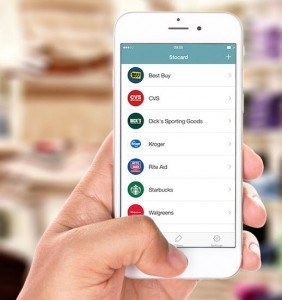 Every Friday I try to share one of my favourite finds of the week – a web-site, tool or app that has impressed me.
Every Friday I try to share one of my favourite finds of the week – a web-site, tool or app that has impressed me.
My Friday Favourite this week is Stocard – The Loyalty Card App.
Loyalty Card App
If you’re anything like me then you have a wallet/purse stuffed full of loyalty cards for various shops and institutions, plus a dozen more loyalty cards that sit at home gathering dust — unavailable to you when you actually need them!
 Stocard allows you to store your loyalty cards in an app on your Smartphone. The next time you need a specific loyalty card, whip out your Smartphone, select the loyalty card in the Stocard app, and Stocard presents a bar code to be scanned.
Stocard allows you to store your loyalty cards in an app on your Smartphone. The next time you need a specific loyalty card, whip out your Smartphone, select the loyalty card in the Stocard app, and Stocard presents a bar code to be scanned.
No more forgetting cards or missing rewards, and you can benefit from a thinner and less heavy wallet or purse.
Download Stocard
StoCard is completely free to download for Android from the Google Play store, iOS from the App store and Windows Phone.



April 14, 2015
The Globalization of SMB Webinar
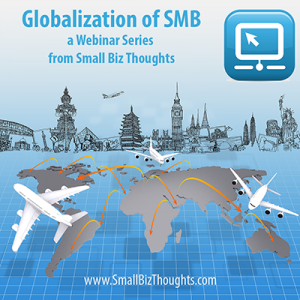 A heads-up that I’ll be joining my good friend and author Karl Palachuk of SmallBizThoughts for the latest episode in his series of webinars on the Globalization of SMB.
A heads-up that I’ll be joining my good friend and author Karl Palachuk of SmallBizThoughts for the latest episode in his series of webinars on the Globalization of SMB.
The Globalization of SMB
The world is getting smaller and we’re all more connected than ever before. How does this affect Small and Medium businesses (SMB’s), IT Consultants, IT Service Providers and Managed Service Providers and what are the opportunities you can take?
In the webinar, Karl and I will address many of the aspects of the globalization of SMB — including working across borders and time zones — and based on our experience working with partners all across the world, we’ll offer practical advice on how your business can benefit from globalization.
Register for the webinar
The Globalization of SMB webinar with Richard Tubb and Karl Palachuk takes place on April 28th, 2015.
You can register for the Globalization of SMB webinar for free now.



March 27, 2015
Placeit – Free Product Mockups
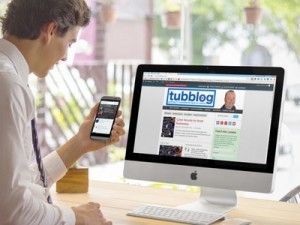 Every Friday I try to share one of my favourite finds of the week – a web-site, tool or app that has impressed me.
Every Friday I try to share one of my favourite finds of the week – a web-site, tool or app that has impressed me.
My Friday Favourite this week is Placeit – Free Product Mockups.
Free Product Mockups
Placeit is a web service that allows you to use over 660 free product mockups to display your application or website.
You can see an example of how you might use this in the image I’ve placed in the top right, showing this blog pictured on an iPad and Apple Mac Pro screen.
Creating the Mockup
 To create the mockup, you simply upload your screenshot image to one of the templates and Placeit produces the finished image for you to download and use.
To create the mockup, you simply upload your screenshot image to one of the templates and Placeit produces the finished image for you to download and use.
Placeit also produces demo videos that can include hand gestures — useful for any App or Website developers.
Using Placeit
Placeit is free to register for and to download small mockup images (such as the one I’ve used above) from. Placeit has subscription plans starting at $12 per month for high resolution images.



March 23, 2015
Cyber Security for Small Businesses
 For most of us, when we think of Cyber Security our thoughts typically turn to high profile cases such as the Sony Pictures Entertainment hack and the Edward Snowden NSA leaks. Highly visible instances of valuable data being leaked.
For most of us, when we think of Cyber Security our thoughts typically turn to high profile cases such as the Sony Pictures Entertainment hack and the Edward Snowden NSA leaks. Highly visible instances of valuable data being leaked.
But what does Cyber Security mean to the average small business? Judging by my conversations with many small business owners, there is a prevailing attitude that Cyber Security is a concern for governments, large corporations and banks — not small businesses. After all, don’t those committing cyber security crimes want to go after the big fish rather than the minnows?
Cyber Security for Small Businesses
Unfortunately for small businesses, that definitely isn’t the case. Rarely a week goes by recently without me speaking to an IT Solution Provider or Managed Service Provider (MSP) who shares with me that one of their clients who they provide outsourced IT for — typically a small business with less than 25 employees — has suffered a serious cyber security breach.
And I do mean serious.
We’re not talking an small interruption to business. The cases I’m hearing about typically involve the entire businesses IT infrastructure being taken off-line as both the business owner and their IT provider scramble to stem the damage and restore order — not to mention the post-breach audit to ascertain the scope of the data protection breaches that have potentially occurred.
According to PwC, the average cost of a small businesses worst breaches costs between £65,000 and £115,000 on average. For the average MSP, how many of your clients could afford that type of impact? Not many, I suspect.
The impact on MSP’s
 The impact of poor Cyber Security for Small Businesses is high for the small business client themselves, but it’s worth being aware of the impact on the MSP who is serving them too. At best it is highly stressful for those involved, but at worst I’ve seen it impact an MSP’s ability to deliver projects to other clients and have a knock on effect that lasts for weeks and sometimes month as they throw all available resources at the Cyber Security breach.
The impact of poor Cyber Security for Small Businesses is high for the small business client themselves, but it’s worth being aware of the impact on the MSP who is serving them too. At best it is highly stressful for those involved, but at worst I’ve seen it impact an MSP’s ability to deliver projects to other clients and have a knock on effect that lasts for weeks and sometimes month as they throw all available resources at the Cyber Security breach.
So what can MSP’s do to mitigate the risk to their clients businesses and in turn, their own business?
There are three broad areas in which MSP’s can help their small business clients become more savvy with Cyber-Security — tools, policies and above all, education for their clients.
Train Employees
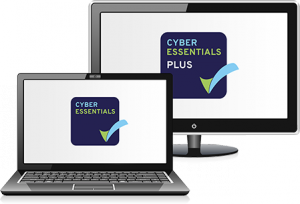 In the UK, Cyber Essentials is a new Government-backed and industry supported scheme to educate on Cyber Security for Small Businesses and guide small businesses in protecting themselves against cyber threats. If you’re a UK IT businesses and haven’t got involved — then you should.
In the UK, Cyber Essentials is a new Government-backed and industry supported scheme to educate on Cyber Security for Small Businesses and guide small businesses in protecting themselves against cyber threats. If you’re a UK IT businesses and haven’t got involved — then you should.
But educating clients to the threat of Cyber Security for Small Businesses is an MSP’s role too. Share information with your clients through Direct Mail (a letter is often more effective than an email), newsletters, social media and importantly, in person.
Throw lunch’n’learns to demonstrate how to stay safe on-line. Nothing motivates people to give up their time and listen more than free Pizza during a lunch hour! Experience shows me that this is time well spent. As well as showing the client you care about their business wellbeing, these sessions actively reduce your own cost of support — the ROI on a Pizza, if you will.
Above that, reach out to your local Police force and offer your help as an IT Professional. I can tell you that Cyber Security is an issue that is landing on many a Chief Superintendent’s desk — and it’s an issue they want help from local businesses in tackling.
AntiVirus
 AntiVirus software should be a product that sits in the background and silently protects client workstations while pro-actively alerting their IT supplier to any emerging issues.
AntiVirus software should be a product that sits in the background and silently protects client workstations while pro-actively alerting their IT supplier to any emerging issues.
Viruses are not the only threat any more — think viruses, rootkits, malware, phishing, web threats and much more.
Many MSP’s inherit all manner of AntiVirus software from clients. As IT provider, find a product that takes care of PCs and Macs, Servers and Workstations under one license structure, and which can be managed from a single web-based management console.
I’d also recommend a product that can automatically discover and deploy to new network computers as they are found, as well as be deployed remotely to machines that aren’t permanently within the office.
A quick look at the AVTest – the Independent IT-Security Institute – shows BitDefender Small Office Security featuring BitDefender Antivirus is the best performing corporate product. It’s a very competitive market.
Whichever AntiVirus product you choose, make sure to choose a product and stick with it across your clients, rather than leaving your clients to choose their own product.
Patch Management
Any MSP worth it’s salt should implement a Remote Monitoring and Management product. Remote visibility of all of your clients infrastructure is an investment, not a cost and is an essential Cyber Security for Small Businesses tool.
The current leader in the UK is MAXfocus and whichever RMM you choose you should invest time in configuring the vulnerability scanning and alerting, and understanding how to effectively deploy patches.
Many MSP’s I know shy away from these features taking a “If ain’t broke, don’t fix it” approach. Sadly, that approach is what leads to products not being patched in a timely fashion and vulnerabilities being exploited.
Spend the time now training up on how to use the patch management options in your preferred RMM tool. It is an investment in time that will reap rewards when you need to rapidly deploy a hotfix to a new vulnerability, or highlight a glaring vulnerability that your engineers may otherwise have missed.
Firewall
 I’d be shocked to find any small business not protected by a hardware firewall nowadays, yet many have firewalls that are badly configured either through neglect or through overly complex configurations.
I’d be shocked to find any small business not protected by a hardware firewall nowadays, yet many have firewalls that are badly configured either through neglect or through overly complex configurations.
As an MSP, make sure you regularly audit the IP ports that are open on a Firewall and the users that are allowed VPN access. It’s easy to open a port to get around a short-term problem but then forget to close that port off again, or grant an external contractor VPN access but then forget to deactivate that account when the contractor’s work is done.
Standardise on a Firewall product that your staff are trained on and familiar with.
Schedule regular audits of your clients Firewall. Backup router configurations regularly. Have certainty that the Firewall is protecting your client as it should.
Backup and Disaster Recovery
 Like Cyber Security, most small businesses believe a disaster is something that happens to someone else.
Like Cyber Security, most small businesses believe a disaster is something that happens to someone else.
For UK Small Businesses, the common sentiment I hear is that a disaster is an earthquake, flood or other natural disaster that doesn’t affect the British Isle. In reality a disaster affecting a small business is more likely to be something like a Cryptolocker virus that wipes out an entire businesses data without the payment of a ransom to a shady cyber criminal, or a disgruntled exiting employee deleting critical client files. These are the more mundane, but very real disasters that affect small businesses worldwide on a daily basis.
As an MSP, don’t tolerate clients who penny pinch with antiquated tape or rotated USB drive backup routines. Any human element such as swapping tapes or drives inevitably leads to failed backups when you need them the most.
Help your clients invest in an automated offsite backup and disaster recovery solution which will help them get back online as a business quickly and effectively when they need it. Educate your clients that the most valuable element of their business is not hardware, but data — and it should be protected.
Mobile Devices
 As an MSP, does your business have a policy in place for Mobile Devices. You know, all those tablets, smartphones and laptops that your engineers access your client data on?
As an MSP, does your business have a policy in place for Mobile Devices. You know, all those tablets, smartphones and laptops that your engineers access your client data on?
If you don’t have a mobile device policy in place, then implement one now. Lead by example, and then educate your clients as to why they need a mobile device policy in place too.
Mobile Device Management is a technical issue that strays dangerously close into HR territory for most small business. For instance, remote wipe a mobile device that not only contains business data but also a member of staff’s baby photos and guess how that move will be received by the member of staff affected?
While these issues might be difficult and not always about technology, they are an opportunity for MSP’s to step beyond being seen as just the “IT guy” and position themselves as being a real business advisor to their small business clients.
Administrator Accounts
Do you help your clients limit authority to install software, or do you take short cuts when it’s quicker to elevate an end-user to administrator access to resolve some irritating 3rd party Line-of-Business App issue?
Limiting the administrative access your clients employees have access to is old fashioned, for sure, and it remains a solid way to mitigate risk of dodgy software being installed and causing untold grief.
Bonus points for not crumbling in the fact of your clients Managing Director who insists he needs Administrator access on his laptop, only to then complain that the Corporate network is mysteriously infected by a virus after his teenage son used his laptop to download the latest warez.
Strong Passwords
 Some clients might complain, whinge, bitch and piss about the perceived irritation — but having a strong password policy, with complex strong passwords and password changes being regularly required — is important.
Some clients might complain, whinge, bitch and piss about the perceived irritation — but having a strong password policy, with complex strong passwords and password changes being regularly required — is important.
It’s not that difficult. Password managers such as LastPass should mean that your client never has to use the same password at multiple web sites or remember dozens of different complex passwords again.
Two-Factor Authentication is now the standard at cloud companies such as Google, Microsoft, Dropbox, Facebook, Evernote and others. If you and your clients have a Smartphone, they can use Two-Factor authentication easily.
Again, it’s all about educating the small business client. Demonstrate how easy it is to use strong passwords. Highlight the pitfalls to your small business clients in not doing so.
Conclusion
While most Small Businesses believe Cyber Security is a concern for governments, banks and large enterprises, the reality is that small businesses are being impacted every single day.
As an IT Solution Provider or Managed Service Provider (MSP), your job is to educate your clients about Cyber Security for Small Businesses and the risks of neglecting to protect themselves.
Because at the end of the day, when — not if — a cyber-security breach happens at your small business client, the impact will not only have a devastating effect on the small business, but your business too.




